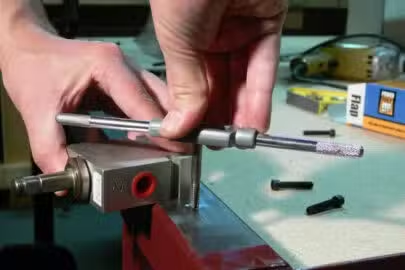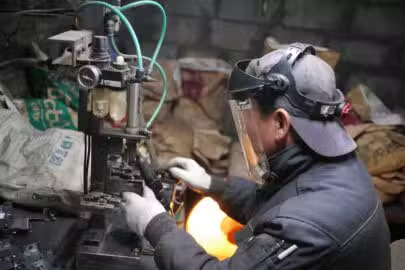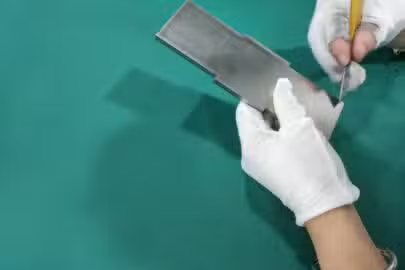Sheet metal fabrication allows you to create various products by combining various techniques and materials. As a result, the popularity of sheet metal manufacturing technology demonstrates its importance in multiple applications. However, it is essential to understand how this process works and how you can benefit from it.
This article discusses the fundamentals of sheet metal fabrication, including techniques and applications. You will also learn about the process’s various benefits, as well as the best materials and surface finishes for metal fabrication. Continue reading to learn more about the sheet metal process.
What Is Sheet Metal Fabrication?
Sheet metal fabrication refers to converting sheet metal into designed shape parts. We divided the processes into three categories for this guide: cutting, deformation, and assembly.
Steel, stainless steel, aluminum, zinc, and copper are common sheet metals, with gauges ranging from 0.006 to 0.25 inches (0.015 to 0.635 centimeters) thick. Thinner gauges are more malleable, whereas thicker gauges may be better suited to heavy-duty parts with demanding applications.
Sheet metal fabrication can be a more cost-effective alternative to casting and machining for partially flat or hollow parts. The process is also quick and wastes little material. Sheet metal fabrication is widely used in producing consumer and industrial parts, as well as in specialized sectors such as automotive, aerospace, energy, and robotics.

What Are the Common Types of Sheet Metal Fabrication Processes?
The designs must be translated into three-dimensional, functional components by putting each part through the necessary metal fabrication processes. The following list includes the most common sheet metal fabrication process:
Cutting
The process of manufacturing sheet metal usually begins with cutting. It involves cutting the metal sheet into the required shape with specialized instruments like shears or laser cutters. More specifically, shear can be used to cut through metal sheets by applying shear forces. This kind of cutting involves three options: shearing, punching, and blanking.
However, sheet metal fabricators also use shear-free cutting techniques. For industrial projects that need faster lead times and precise cutting, this is the best method.
Furthermore, the recommended technique for producing high-quality cuts is laser cutting. Consequently, we advise using a reputable sheet metal laser cutting service. We believe that this method is more appropriate for use in industrial settings. Laser cutting saves time and allows for a high degree of precision (+/- 0.1 mm).
Bending
There are many different forms and angles that can be produced by bending, ranging from straightforward bends to intricate shapes that need several bends. The production of high-volume, consistently quality parts can be achieved at a reasonable cost through the bending process.
Bending the metal sheet into the required shape or angle requires a press brake machine. A highly skilled manufacturer is needed for the process of bending, which, despite its apparent simplicity to the untrained eye, is quite complex.
This can be attributed mainly to “spring back,” the phenomenon wherein bent metal always attempts to return to its original, flat shape. Operators must overbend the part in order to achieve the required spring-back angle in order to solve this issue.

Punching
Punching is a useful method for many different types of metal sheets. Fabricators create the required shape and size of the hole in the metal sheet by pressing the punch through it during the punching process.
Once the hole has been created, place the die beneath the metal sheet to gather the scrap material. Punching can not only make holes in the metal sheet but also indentations and features like countersinks or dimples.
Large holes up to 50 mm in diameter can be made with our CNC punching capabilities at Zintilon. The finished parts will meet all necessary standards and specifications thanks to the accuracy and efficiency of this technique’s hole punching.
Welding
In sheet metal fabrication, welding is a crucial step that unites metal components to form a single part. TIG welding, MIG welding, and Stick welding are just a few of the different welding techniques available.
While the methods used by the various welding techniques vary, they all aim to fuse metal parts together by melting their edges and incorporating filler material. The pieces are firmly fused by the metallurgical bond created during this process. Naturally, welding is only required when a product has two or more distinct parts.
Assembly
Assembly is the last stage of the metal fabrication process, and it allows for the construction of intricate metal components and structures. Sheet metal fabricator can produce high-quality goods that adhere to all necessary standards and specifications by employing the appropriate methods and techniques.
The assembly can be completed using a variety of techniques, such as adhesive bonding, welding, and mechanical fastening. Bolts, screws, or other fasteners are used in mechanical fastening to hold metal components together. Welding ensures that the finished product is robust and long-lasting By permanently joining the components.
Adhesive bonding is frequently used to create lightweight structures or in situations where welding is not practical. It can be used for both temporary and permanent assemblies. Assembly can be a difficult process that calls for a high level of competence. To prevent any problems with the finished product, it is essential to assemble all parts precisely and securely.
Advantages Of Sheet Metal Manufacturing
Sheet metal fabrication includes a variety of techniques used to create rapid prototyping parts for a wide range of industries. The following are some of the major benefits of sheet metal fabrication:
Accuracy and Efficiency
Sheet metal technology improves efficiency and accuracy in fabrication. It aids in the production of prototypes with high precision and accuracy. Some laser cutters, for example, can make cuts as small as 0.0005 inches.
Furthermore, it is critical to understand that most sheet metal techniques are automated. So, once you enter the codes into the computer, the machines begin to function. The process eliminates human errors. As a result, the final products usually have few or no deformations.
Various Techniques and Materials
The sheet metal fabrication process involves a number of techniques. As a result, there are numerous techniques to choose from for your project.
You can also choose from a variety of sheet metal materials, such as copper, stainless steel, steel, aluminum, and other custom sheet metals, using this manufacturing process. The material you select will determine how your finished product will be used.
Manufacturing of Lightweight Components
The production of lightweight components is best suited for sheet metal manufacturing. Custom sheet metal fabrication provides superior-quality materials and techniques necessary for industries like aerospace and automotive that require lightweight engine parts.
Additionally, this manufacturing process aids in producing sheet metal fabrication parts that ensure efficiency while enhancing fuel economy in cars and aircraft.
Perfect Materials for Fabricating Sheet Metal
It is essential to use appropriate material for your sheet metal fabrication project to achieve the best results. This section will go over some of the best sheet metal fabrication materials. Remember that there are numerous types of sheet metal, so consult with a professional before making any final decisions.
The following are some of the most highly recommended materials:
Stainless Steel
A popular sheet metal fabrication material is stainless steel. It is also strong and long-lasting, making it suitable for various applications. Stainless steel is also corrosion-resistant and straightforward to work with.

Brass
Brass is a copper/zinc alloy. Because of its strength, flexibility, and durability, it is ideal for metal fabrication projects. It is frequently used to create fabricated parts for various industries.
Carbon Steel
Carbon steel is a carbon-containing steel. It is a popular material among sheet metal fabricators. Because of its physical and structural properties, such as strength, flexibility, and hardness, it is ideal for various heavy-duty projects.
Aluminum
This is one of the most commonly used materials in sheet metal fabrication. It is lightweight, strong, and resistant to corrosion. It is also simple to work with and can be used to make various products.
Copper
This is a soft, malleable metal that is simple to work with. It is pretty resistant to heat and corrosion. Because of their conductivity, its fabricated parts are frequently used in electrical applications.
Surface Finishes for Sheet Metal Fabrication
Here are the common surface finishes for sheet metal fabrication:
It is frequently used for both decorative and corrosion-resistant purposes. One of its most common applications is chrome plating, widely used in the automobile industry.
- Bead Blasting
Bead blasting requires spraying a high-speed sand or other abrasive jet against the sheet metal to give it a matte texture and prepare it for coating.
This is the process by which a cloth wheel “buffs” or rubs the metal surface to make it appear shiny.
This is directly spraying the metal component with powdered paint, then curing it in an oven or under UV light to create a glossy or semi-gloss texture layer that is resistant to wear.
- Anodizing
It contributes to the metal’s exceptional resistance to corrosion and wear by thickening the natural oxide layer on it. With a smooth, matte finish, it increases the surface’s hardness and durability.
Design Tips For Sheet Metal Fabricating

Here are some essential design tips to consider for sheet metal fabrication:
Hole and Slot Positioning
When producing parts for custom sheet metal fabrication, hole, and slot diameters are crucial considerations. The material’s thickness should match the diameter of the holes and slots. You should also leave adequate space between each hole. The holes should never be positioned too near to the material’s edge.
Wall Thickness
Because sheet metal fabrication parts are made from a single metal sheet, each component’s geometry needs to maintain a consistent thickness. In general, sheet metal components can be produced with thicknesses ranging from 0.9 mm to 20 mm.
Nonetheless, a variety of thicknesses can be achieved with different custom sheet metal fabrication techniques. For example, metal that is between 0.5 and 10 mm thick is suitable for laser cutting. On the other hand, metal sheets with a thickness of 0.5 mm to 6 mm can be bent using sheet metal bending.
Bend Radii
It is essential to maintain the internal bend radius of sheet metal at a value equal to its thickness. It keeps final products free from distortions and flaws in sheet metal. Therefore, in sheet metal engineering, maintaining uniform bend radii throughout the part contributes to ensuring excellent orientation and cost-effectiveness.
Bend Allowance and Deduction
The extra length of material you must add to the part’s actual measurement to create a flat pattern is known as the bend allowance. However, to achieve a balanced design, bend deduction refers to the amount of material that must be removed from the flanges’ length.
Sheet Metal Fabrication Applications

Numerous industries use sheet metal fabrication for functional components, decorative elements, and structural applications. Sheet metal fabrication finds wide-ranging applications in industries such as:
Transportation
Thousands of different products manufactured with metal fabrication are used in the transportation industry. For instance, sheet metal fabrication is used in emergency vehicles to build steel surrounds for tail-lift doors, side steps, door handle mounts, and glove-box enclosures.
A great way to make parts for vehicle construction, both big and small, is through sheet metal fabrication. Furthermore, sheet metal fabrication creates stair-safe products, ladder hatch trap doors, and safety rails on construction sites.
Science, Medical & Food
Sheet metal fabrication is used extensively in the scientific, medical, and food industries to create products in commercial and industrial kitchens, such as worktop surfaces, storage units, and sinks.
In many food production and preparation applications, stainless steel is typically the material of choice.
Kiosks, Vending Machines & Enclosures
For many businesses that interact with customers, like gyms and recreation centers, vending machines and kiosks generate substantial revenue. Because of this, caution must be used when building them.
Sheet metal fabrication is necessary for these kinds of machines because they require a lot of individual components to be built.
Retail
Sheet metal fabrication is needed in the retail industry to create visually appealing merchandise and product displays.
Various retail display units, retail spaces, and shop displays can be made with sheet metal fabrication. Point-of-sale stands, portable displays, retail display cubes, and bar displays are a few examples. These goods must be both very functional and visually appealing.
Construction & Security
Sheet metal fabrication is employed in the construction and security industries to create products like guard rails, security doors, security grills, and custom security enclosures.
Cost Considerations in Sheet Metal Fabrication
A number of variables determines sheet metal fabrication costs:
- Tooling Cost
The complexity of the part’s design will determine how much this will cost.
- Material Cost
Depending on the kind of metal, sheet metal prices can differ substantially.
- Overall Cost
Because of the high initial tooling costs, the total cost for a small batch of custom parts could be several thousand euros. In large-scale manufacturing, the price per unit may decrease dramatically.
Other variables that affect costs are the location of the manufacturing facility, particular design specifications, and the state of the market.
Do You Need High-quality Sheet Metal Fabricated Parts?
Fabricating sheet metal is both an art and a science. Every project requires a skilled metal fabricator due to its wide range of nuances and techniques. You are familiar with the fundamentals of sheet metal design, so leave the rest to an expert service!
You can benefit from both our automated and incredibly efficient production service and sheet metal manufacturing services when you work with Zintilon CNC services. You can anticipate lead times as short as three days and a quote from us in as little as 12 hours.
Our rapid prototyping service also includes a solid and dependable manufacturing capability (led by a team of experts) and technical and quality assurance.
Conclusion
Sheet metal fabrication is a great way to manufacture parts. It has several advantages, including accuracy and efficiency, the ability to fabricate lightweight components, and compatibility with various materials and methods. Understanding the different techniques, tools, and design advice associated with this procedure is therefore crucial to accomplishing your project.
FAQs
What Is the Maximum Thickness That Can be Fabricated in Sheet Metal?
Sheet metal typically comes in thicknesses of 0.5 mm to 6 mm. The metal sheets’ thinness makes them incredibly simple to fabricate while still offering sufficient strength for the intended uses.
Which Are the Principal Methods Used in Sheet Metal Fabrication?
The primary methods of fabricating sheet metal are typically divided into three groups. Cutting, forming, and joining are a few of these. There are different numbers of distinct processes in each category, each with multiple applications.
How Does the Sheet Metal Fabrication Process Work?
Through cutting, forming, and joining, sheet metal materials are manipulated or altered into various geometries during the fabrication process. Engineering drawings and concept creation are the first steps in the process.
Then, using a variety of techniques, engineers create prototypes in accordance with the design model. Full-scale production of the intended products can then start following the development of prototypes, product testing, and design modifications.




